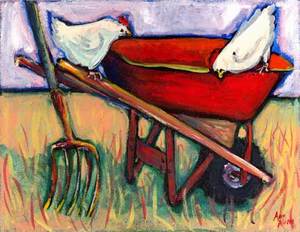"so much depends
upon
a red wheel
barrow
glazed with rain
water
beside the white
chickens."

The poem is "The Red Wheelbarrow" William Carlos Williams, 1883 – 1963
Williams called this poem "quite perfect" and since its publication in 1923 it has been a staple of classrooms. People have wondered " Where is this wheelbarrow and who owned it ?" But now 90 years later the owner of the wheelbarrow has been identified.
On July 18, in a moment of belated poetic justice, a stone will be laid on the otherwise unmarked grave of Thaddeus Marshall, an African-American street vendor from Rutherford, N.J., noting his unsung contribution to American literature.
William Logan a professor at the University of Florida has published an essay on the poem in the most recent issue of the literary journal Parnassus It considers the poem from seemingly every conceivable angle. But also traces back the owner of the wheelbarrow. The story is the subject of a NY Times book review article
In a note quoted in a 1933 anthology, Williams said he had seen the wheelbarrow “outside the window of an old negro’s house on a backstreet” in Rutherford, where Williams also lived and regularly paid house calls to patients in the African-American neighborhood.
Logan’s clues for identifying Marshall came from the 1920 census, a 1917 insurance map and the help of a local historian. The man – Thaddeus Marshall, a 69-year-old widower who lived with a son named Milton at 11 Elm Street, about nine blocks from Williams’s house. He located a great-granddaughter, Teresa Marshall Hale, of Roselle, N.J., who grew up in the house on Elm Street and recalled family stories about her great-grandfather selling eggs and vegetables.
Funds were raised for a marker on Marhsall’s grave since he was buried without a headstone. A red and white wreath, signifying the red wheelbarrow and white chickens, will be laid beside it.
Just as religion, poetry is important to us as a way to go deeper within ourselves, a different way of viewing experience. Images like this become part of whom we are.

